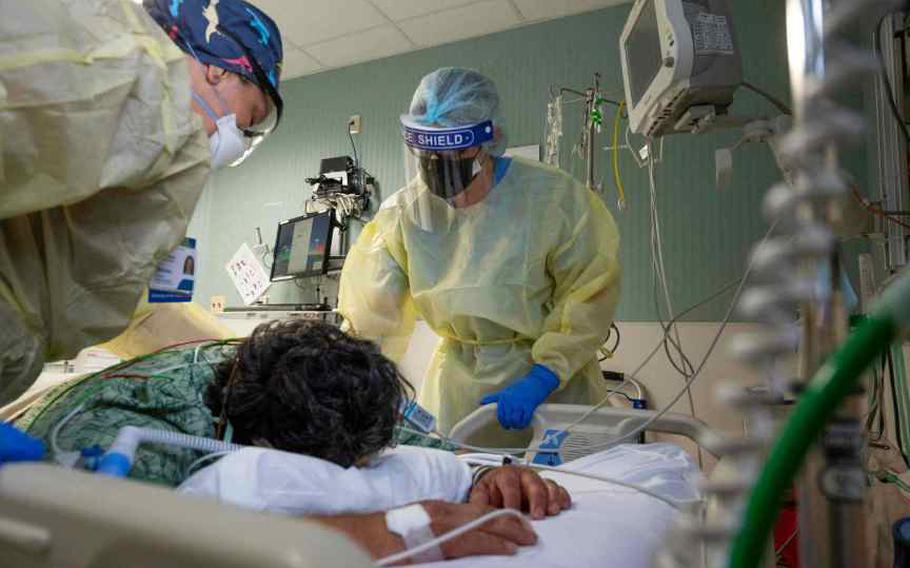
Nurses Assistant Vanessa Gutierrez, left, and Jamie McDonough, RN, talk to a COVID-19 patient in the COVID ICU at St. Joseph Hospital in Orange, CA, on Wednesday, July 21, 2021. As of July 14, 2022, the number of COVID patients in California hospitals has more than quadrupled since mid-April. Doctors who treat these patients are seeing consistent indications that, for most, the disease is less severe than in earlier surges of the deadly virus that killed more than a million Americans. (Paul Bersebach/Orange County Register)
Stars and Stripes is making stories on the coronavirus pandemic available free of charge. See more stories here. Sign up for our daily coronavirus newsletter here. Please support our journalism with a subscription.
(Tribune News Service) — COVID hospitalizations are rising again after more than two months of persistently high case rates in the Bay Area and California. But the doctors who treat these patients are seeing consistent indications that for most, the disease is less severe than in earlier surges of the deadly virus that has killed more than a million Americans.
“What we are not seeing is patients like we saw in 2021 and 2020 — someone with no medical issues coming in and requiring oxygen,” said Dr. Errol Ozdalga, a clinical associate professor of medicine at Stanford.
The increase has been much more gradual than during other COVID waves, likely due to widespread vaccination and booster coverage, and improved therapeutics and treatments which prevent some hospitalizations and shorten others. And the hospitalizations now are still well shy of the record 20,000-plus COVID patients in California hospitals during the first winter surge in 2020-21, and less than one-third of the 15,000 hospitalized this past winter.
Still, the threat of serious illness and even death among some populations remains a real concern.
Ozdalga and Dr. William Collins, another professor at Stanford’s medical school, recently took a close look at the COVID patients that came through Stanford’s hospital during the first omicron surge in December and January, and again more recently, to better understand how the threat posed by the virus has changed.
“What you really want to know is how dangerous COVID is,” Ozdalga said.
They found that of the nearly 100 patients hospitalized in recent weeks at Stanford who tested positive for COVID, 35% were being treated for severe disease caused by the virus, while the other patients were mainly being treated for non-COVID related issues. Some among the 35% were medically vulnerable patients who were admitted out of an abundance of caution after testing positive.
UCSF hospitals reported a similar proportion among patients who are hospitalized because of the virus. As of Friday, they had 46 patients who tested positive for COVID, but 24 of those had been admitted for other medical reasons. In earlier COVID waves, in contrast, a much larger proportion of patients were admitted for treatment of severe disease, suggesting the virus was more threatening at that point than it is now.
“The people we are seeing who have severe illness now are largely unvaccinated, including young people,” said Dr. Peter Chin-Hong, a UCSF professor of medicine who specializes in infectious diseases, “and those who are unboosted who are older than 65, and those who are immunocompromised.”
The number of COVID patients in California hospitals has more than quadrupled in the past three months. As of Thursday, 4,432 patients had COVID, up from a low of 949 on April 16.
What affects your chances of being hospitalized for COVID? “Vaccination status is number one,” said Chin-Hong. “Age is number two.” And he’s especially concerned about people over 65 who are not fully boosted.
From what he is seeing at UCSF, Chin-Hong says the people getting hospitalized at this point “are mainly unvaccinated … but among those hospitalized who are vaccinated, it’s the unboosted,” who are getting super sick.
Californians who are not fully vaccinated are 9.4 times more likely to be hospitalized for COVID, according to the most recent data available from the California Department of Public Health.
COVID hospitalizations have dipped below 1,000 for only a handful of days since reliable tracking began in April 2020. For a few days in late June 2021, and a few days in late April 2022, the number of patients in California was under 1,000.
The number of people in California hospitals who have tested positive for COVID is a metric the state has used since the first summer wave in 2020 to measure the real-world impacts and severity of the pandemic.
“The fact that people are still dying in America is really a tragedy,” said Chin-Hong, pointing to the availability of effective vaccinations, boosters and therapeutics, such as Paxlovid. “There are three alternatives for Paxlovid to help people stay away from the hospital.”
But as for how dangerous COVID is now for the average, vaccinated person? “I caught it in May and I was never once worried about getting hospitalized,” Ozdalga said. “If I had gotten it last year I would have been really worried.”
--------
Visit at mercurynews.com.
Distributed by Tribune Content Agency, LLC.